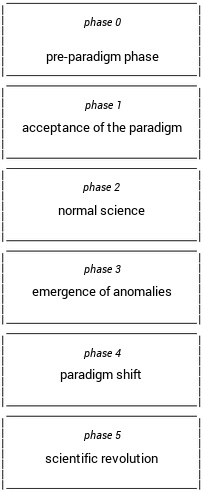Difference between revisions of "Introduction1"
| (3 intermediate revisions by the same user not shown) | |
(No difference)
| |
Latest revision as of 20:01, 18 March 2022
We would like our reader to have an immediate perception of the topics that will be debated in Masticationpedia; we will review some of the most current issues concerning the epistemological evolution of science in general, and medical as well as dental medicine in particular.
In this phase we will consider the two fundamental aspects of Progress of Science, according to the Kuhn Paradigms, and Epistemology which questions the concepts of "Statistical Inference" and "Interdisciplinarity".
These two themes, which apparently seem to be in conflict with each other, as the first one needs disciplinarity to highlight the "Anomalies in the Paradigm" and the second needs "Interdisciplinarity", they will integrate through a resolving element that consists of "metacognitive scaffolds", i.e. cognitive bridges between specialist disciplines. In this context, therefore, the reader will be better able to appreciate the stochastic approach towards one of the most controversial topics in masticatory rehabilitations, such as, "Malocclusion", from which come most of the masticatory rehabilitation procedures such as orthodontics, prosthesis and orthognathic surgery.
So, in addition to anticipating the scientific and philosophical aspect of Masticationpedia, we will finally focus on topics such as "Complex Systems", the "Emergent Behaviour" of Complex Systems and "System’s Coherence": necessary steps to introduce scientific clinical topics which bring with them doubts, questions and at the same time paradigmatic innovations tending to change the status quo of the deterministic and reductionist clinical thinking routine, before a stochastic and interdisciplinary language logic.
Article by Gianni Frisardi
|
Ab ovo[1]
Before getting to the heart of the Masticationpedia treatment, a premise is appropriate, that mainly concerns two aspects of the social, scientific and clinical reality of the current and the immediately preceding era.
In the last century, we witnessed exponential growth in technological and methodological "Innovations" specifically in dentistry[2]; these innovations have in some way influenced decision-making strategies, opinions, schools of thought and axioms in order to improve quality of life, as stated in the "Exposure Science in the 21st Century"[3]. However, this exponential growth brings with it, implicitly, conceptual gray areas (in practical terms "side effects") which are sometimes underestimated, but which may call into question some Scientific Certainties or make them less absolute and more probabilistic.[4]
The two sensitive aspects of the current social, scientific and clinical reality (which seem to conflict with each other, but as we will see at the end of this reading will be complementary) are the "Progress of Science" according to Kuhn and the "Epistemology".
Progress of Science according to Thomas Kuhn
Thomas Kuhn in his most famous work states that science cyclically passes through some phases indicative of its operation.[5][6] According to Kuhn, science is paradigmatic, and the demarcation between science and pseudoscience can be traced back to the existence of a paradigm. The evolution of scientific progress is assimilated to a continuous curve which undergoes discontinuity in paradigm changes. For example, in phase 2 of the Kuhn Paradigms, called Normal Science, scientists are seen as problem solvers, who work to improve the agreement between the paradigm and nature.
This phase, in fact, is based on a set of basic principles dictated by the paradigm, which are not questioned but which, indeed, are entrusted with the task of indicating the coordinates of the works to come. In this phase, the measuring instruments with which the experiments are made are developed, most of the scientific articles are produced and its results constitute significant growth in scientific knowledge. In the normal science phase both successes and failures will be achieved; the failures are called by Kuhn anomalies, or events that go against the paradigm.
As a good problem solver, the scientist tries to solve these anomalies.
Kuhn's phases in Dentistry
Kuhn, however, divides the evolution of a paradigm into five phases; this is a fundamental process for Masticationpedia, but to keep tuned with the project, we will limit ourselves to describing the two most significant phases:
| |
|
It is almost obvious that Kuhnian scientific philosophy prefers disciplinarity, as an anomaly in the genomic paradigm will be noticed better by a geneticist than by a neurophysiologist. Now this concept would seem to be in contrast with the epistemological evolution of Science, so it is better to stop a minute upon it in detail.
Bibliography
- ↑ Latin for "since the very beginning"
- ↑ Heft MW, Fox CH, Duncan RP, «Assessing the Translation of Research and Innovation into Dental Practice», in JDR Clin Trans Res, 2019.
DOI:10.1177/2380084419879391 - ↑ «Exposure Science in the 21st Century. A Vision and a Strategy», Committee on Human and Environmental Exposure Science in the 21st Century; Board on Environmental Studies and Toxicology; Division on Earth and Life Studies; National Research Council..
ISBN: 0-309-26468-5 - ↑ Liu L, Li Y, «The unexpected side effects and safety of therapeutic monoclonal antibodies», in Drugs Today, 2014, Barcellona.
DOI:10.1358/dot.2014.50.1.2076506 - ↑ Thomas Samuel Kuhn (Cincinnati, 18 july 1922 – Cambridge, 17 june 1996) was an American philosopher of science.
See Treccani, Kuhn, Thomas Samuel. Wikipedia, Thomas Kuhn. - ↑ Kuhn Thomas S, «The Structure of Scientific Revolutions», Univ. of Chicago Press, 2012, Chicago.
ISBN: 9780226458113
